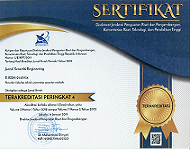Efektivitas Free Floating Wetland Tanaman Kiambang (Salvinia Molesta) Dengan Penambahan EM4 Dalam Pengolahan Limbah Laundry Pada Kondisi Anoxic–Oxic
Keywords:
COD, DO, EM4, Free Floating Wetland, Kiambang, Limbah Laundry, SurfaktanAbstract
Laundry wastewater contains organic matter and detergents that have the potential to pollute the environment if not properly treated. One environmentally friendly method to address this problem is the free floating wetland (FFW) system, which utilizes aquatic plants and microorganisms. This study aimed to evaluate the effectiveness of water lettuce (Salvinia molesta) combined with 5% Effective Microorganisms 4 (EM4) in reducing Chemical Oxygen Demand (COD) and surfactants, as well as increasing Dissolved Oxygen (DO) levels in laundry wastewater. The experimental design consisted of two treatments: FFW with and without EM4 addition, over a 5-day retention time divided into an anoxic phase (day 0 to day 2) and an oxic phase (day 3 to day 5). The results showed that the combination of water lettuce and 5% EM4 was able to reduce COD by up to 80.9% and surfactants by 65%, while increasing DO to 5.02 mg/L. This success is attributed to the root system of the water lettuce, which enhances oxygenation in the rhizosphere zone, thus supporting the growth and activity of aerobic microorganisms. FFW based on water lettuce with EM4 addition has the potential to be an effective, sustainable, and environmentally friendly laundry wastewater treatment technology.
References
[1] P. Ardiyanto and M. G. C. Yuantari, “1. Analisis Limbah Laundry Informal Dengan Tingkat Pencemaran Lingkungan Di Kelurahan Muktiharjo Kidul Kecamatan Pedurungan Semarang,” Jukung (Jurnal Tek. Lingkungan), vol. 2, no. 1, pp. 1–12, 2016, doi: 10.20527/jukung.v2i1.1055.
[2] V. R. W. Rawung, P. R. R. I. Montong, G. D. Lenzun, and M. T. R. Lapian, “Fitoremediasi Tanaman Kiambang (Salvinia molesta) pada Pengolahan Limbah Cair Peternakan Babi,” Zootec, vol. 44, no. 1, pp. 131–138, 2024.
[3] K. A. Fitria, I. Nurhayati, and J. Sutrisno, “Penurunan Chemical Oxygen Demand ( COD ) Dan Fosfat ( PO 4 -P ) Limbah Laundry Menggunakan EM 4 dan Mikroalga Spirulina sp,” vol. 15, pp. 31–44, 2023.
[4] K. L. Sari, Z. A. As, and Hardiono, “Penurunan Kadar BOD, COD dan TSS Pada Limbah Tahu Menggunakan Effective Microorganism-4 (EM4) Secara Aerob,” J. Kesehat. Lingkung., vol. 14, 2017, [Online]. Available: http://scioteca.caf.com/bitstream/handle/123456789/1091/RED2017-Eng-8ene.pdf?sequence=12&isAllowed=y%0Ahttp://dx.doi.org/10.1016/j.regsciurbeco.2008.06.005%0Ahttps://www.researchgate.net/publication/305320484_Sistem_Pembetungan_Terpusat_Strategi_Melestari.
[5] S. Rezania et al., “The efficient role of aquatic plant (water hyacinth) in treating domestic wastewater in continuous system,” Int. J. Phytoremediation, vol. 18, no. 7, pp. 679–685, 2016, doi: 10.1080/15226514.2015.1130018.
[6] F. Rehman et al., “Optimal root oxygen release from two macrophytes Saururus cernuus L. and Pistia stratiotes L. varies with light and temperature in simulated constructed wetlands microcosms,” Rhizosphere, vol. 26, p. 100697, Apr. 2023, doi: 10.1016/j.rhisph.2023.100697.
[7] G. Dotro et al., Treatment Wetlands: Volume Seven, vol. 7. 2017.
[8] M. M. El Shafei, E. M. A. Elmoteleb, and M. M. El, “Investigate The Effect Of Effective Microorganism (EM) On Improving The Quality Of Sewage Water From Al-Gabal Al-Asfar Area,” pp. 1–9, 2017.
[9] A. G. Ilmannafian, M. Kiptiah, and M. I. Darmawan, “The effectiveness of filtration and phytoremediation with combination of aquatic plants in wastewater treatment of Sasirangan industry The effectiveness of filtration and phytoremediation with combination of aquatic plants in wastewater treatment of Sasir,” IOP Conf. Ser. Earth Environ. Sci., 2021, doi: 10.1088/1755-1315/926/1/012042.
[10] Irhamni, Pandia S., Edison Purba, and Wirsal Hasan. "Kajian akumulator beberapa tumbuhan air dalam menyerap logam berat secara fitoremediasi." Jurnal Serambi Engineering 1.2 (2017): 75-84
[11] N. Hendrasarie and C. Redina, “Ability of Water Lettuce (Pistia stratiotes) And Water Hyacinth (Eichhornia crassipes) To Remove Methylene Blue Anionic Surfactant (MBAS) From Detergent Wastewater,” Nat. Environ. Pollut. Technol., vol. 22, no. 4, pp. 1961–1970, 2023, doi: 10.46488/NEPT.2023.v22i04.022.
[12] V. Vives-Peris, C. de Ollas, A. Gómez-Cadenas, and R. M. Pérez-Clemente, “Root exudates: from plant to rhizosphere and beyond,” Plant Cell Rep., vol. 39, no. 1, pp. 3–17, 2020, doi: 10.1007/s00299-019-02447-5.
[13] T. W. Federle and R. M. Ventullo, “Mineralization of surfactants by the microbiota of submerged plant detritus.,” Appl. Environ. Microbiol., vol. 56, no. 2, pp. 333–339, Feb. 1990, doi: 10.1128/aem.56.2.333-339.1990.
[14] A. J. Willetts and R. B. Cain, “Microbial metabolism of alkylbenzenesulphonates.,” Biochem. J., vol. 120, no. 4, pp. 389–402, 1970, doi: 10.1042/bj1200028pa.
[15] Q. Wu, L. Zhao, R. Song, and A. Ma, “Research progress of surfactant biodegradation,” IOP Conf. Ser. Earth Environ. Sci., 2019, doi: 10.1088/1755-1315/227/5/052023.
Downloads
Published
Issue
Section
License
Copyright (c) 2025 Icha Ayoe Bilbina, Mohamad Mirwan (Author)

This work is licensed under a Creative Commons Attribution 4.0 International License.












